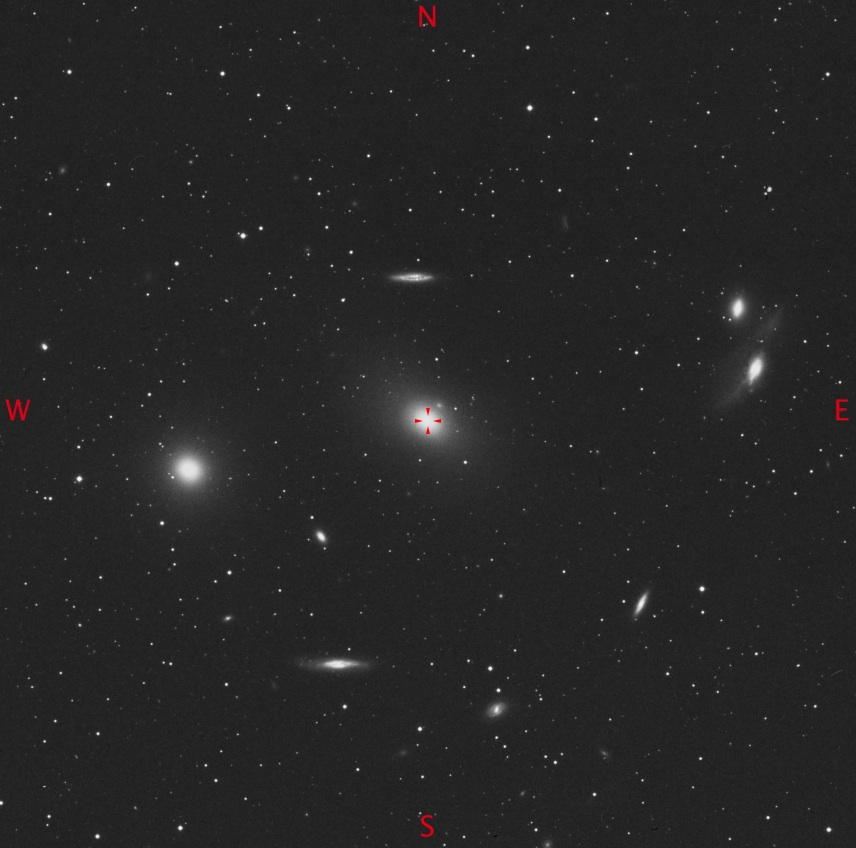(M86, M84, NGC4388, NGC4387 and NGC4402 & lots of other eye candy)
Another two observing nights in a row – again 🙂 Having said that though, the first, last Friday night, the conditions were really poor with a rising full Moon, so I won’t go into too much detail.
hese last few weeks I’ve always tried to observe Comet C/2011 L4 Panstarrs, whenever there has been an opportunity

Couldn’t see it at all for the first half hour as the scope couldn’t slew far enough before hitting the stops to enable the scope to see above the observatory roof.
Wow. What a difference from last week. Couldn’t see it in binoculars and it’s very indistinct even through the Altair Astro 250mm, Plossl 26mm, 78 X, 38.4′ I could only just make out the tail, which I think was running SWW. Really surprised that a one mag reduction would make such a difference in what could be seen.
Cloud started to roll in after 40 mins or so, so closed up. Saturday evening was much better
Not bad at all, bearing in mind all the rubbish we’ve had to look through recently. Seeing and transparency were good above 30 degrees. Anything below that was hidden in a thin haze.
Session Data
- Date: 27/04/2013
- ime: 21:17 – 23:00 UT
- Temp: 4.0c,
- Air Pressure: 1009Mb,
- Humidity: 90%,
- Dew point: 2.4c,
- Wind Speed: 4 MPH .
- Seeing: II Mostly Stable,
- Transparency: Clear ,
- Airmass: for all objects 1.3
All observations made with : Altair Astro 250mm, UWA 18mm, 113 X, 43.6′
M91
Oval oriented NW to SE . Core visible, but it’s difficult to say where the outer edge of Galaxy extends to.
M90
Bright core is almost stellar. Oriented NNE to SSW.
M89
Looked almost circular, with a faint core.
M87
Whoosh meteor, followed by slower moving satellite pass through the FOV while making observation. M87 round in shape, with obvious core. NGC4476 appears brighter at 12.3 mag than NGC 4478 at 11.2 mag. The size of both is similar, but with the fainter galaxy being slightly smaller, but concentrates the apparent brightness enough to make a difference.
M86 and M84
With both these aligned almost East to West, Astroplanner shows that with the 18mm UWA, another three smaller Galaxies should also bee seen in the same FOV. NGC4388, NGC4387 and NGC4402. NGC4388 was faint but obvious and with lots of heavy breathing and averted vision I could just make out NGC4387. But NGC4388 remained undetectable. Unlike in the two Galaxies observed in the M87 observation above, the smaller and only marginally fainter NGC4402 wasn’t seen – Why?
M99
Looked oval, with a visible core, but no other structure observed.
By this time the Full Moon had just started to rise in the SE and flooded my dark sky with light. Before I packed up, I wanted to have another look at Comet C/2011 L4.
C/2011 L4
Much better than my viewing the previous night. Tail flowing through star (SAO11060) at about half the radius of my FOV (Altair Astro 250mm, UWA 18mm, 113 X, 43.6′) However, the tail was still an averted vision feature and certainly didn’t looks as impressive as the views we got a couple of weeks ago when we observed it at the BAA Winchester Weekend.
All in all, I really enjoyed this session. While all of the Galaxies didn’t display any structure, I did feel that my observational skills are slowly improving as I can at least now make out shape and if Oval, a ratio of that ovality. One think is hacking me off though. My PC screen is still to bright. I’ve adjusted all the brightness settings on both the monitor and the driver software. I’ve also installed KnightVisons screen app that simulates a Red – or any other colour you specify, virtual filter having been placed over the screen, but even with all these set quite low, I still find this screws up my dark adaption for at least 5 mins.
While I love Astroplanner 2, their screen layout uses shedloads of white, which I just can’t seem to tame. I’m tempted to go back to SkyTools 3 for the in-observatory operation as their implementation of a Night screen uses lots of Black backgrounds with White text, which is far less damaging on the eyes. The other problem is the screen glare when at the scope. While I can close the lid on the Pulpit, it might be so much easier to turn the whole cabinet, so the screen points away from the scope area. I’m going to have to experiment some more with all the various options and see what works.